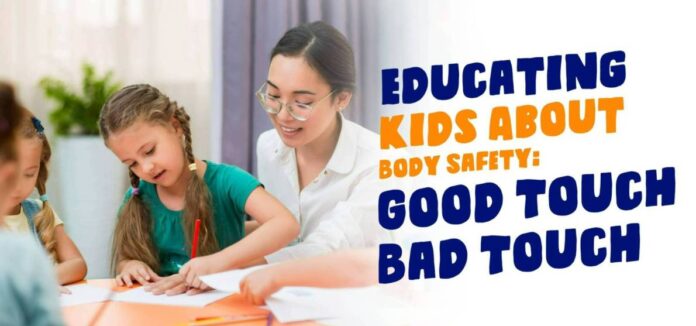Have you ever wondered why child abuse and molestation are increasing day by day?
The fault lies in us because, as parents, we fail to educate our children regarding good touch vs. bad touch. It’s not only a discussion regarding physical touch; it’s about teaching your child about healthy and safe interpersonal interaction.
No doubt, it is a very sensitive topic, but in today’s world, it is mandatory for children to discriminate between good touch and bad touch. Do it now before any misfortune happens.
Defining Good Touch vs. Bad Touch
How can a child differentiate between a good touch and a bad touch?
Tell him to rely on his senses. When a touch gives him a feeling of comfort, warmth, and peace, he calls it a good touch. The priority lies in the secure feeling during the touch.
According to an article by Psychology Today, “good touch can include things like hugs from loved ones, high fives with friends, or gentle pats on the back. These types of touches foster feelings of warmth, connection, and support.
Contrary to that, any kind of action that leaves a child in an uncomfortable situation is a bad touch. When a child feels insecure and does not want to interact physically with someone, this is a bad touch. It can be from a stranger or a family member. Bad touches include pinching, inappropriate taps on the thighs, and touching the private parts.
One more thing: the definition of good touch vs. bad touch is subjective and can vary according to cultural or religious norms and individual preferences.
Methods To Mentor Your Child About Good Touch Vs Bad Touch
Here are several effective ways to approach this topic:
1. Start Early
A report states that in 2021, there were 588,229 victims of child abuse in the United States. Most cases were among young children, with 127,499 victims one year old or younger and a further 138,128 victims between the ages of two and five years old.
What do these stats explain?
It enlightens us about the fact that we should not wait for the right age. Start early and educate your child according to his age. Use appropriate words and vocabulary limited to the child’s age, so he can grasp the concepts without getting confused.
A mere example of this scenario lies in a situation when you teach your child about body parts. Explain to them what their private parts are and how they should not allow anyone to touch them.
2. Use Clear Language
While teaching your child, be specific. Instead of using vague names for body parts, give them their real names. They will feel less shy regarding that topic and can talk about it more conveniently. A child should
As highlighted in an article by Child Welfare Information Gateway, “teaching children the names of their body parts, including private areas, and emphasizing that those parts are private can empower them to recognize and report inappropriate touch.”
3. Teach Consent And Respect
Teach your child how to say no. Their body belongs to them, and they have the right to refuse any sort of touch or interaction if they feel uncomfortable.
In our household, it is a common practice for parents to encourage their children to socialize with people they do not admire. This sort of attitude affects a child’s mental health and makes him docile. It means he will become a scaredy-cat who will even accept assault without complaint. So reflect on your actions; a mere negligence of yours can affect your child’s whole life.
4. Encourage Open Communication
This topic is considered taboo in our society. Many children learn the difference between good touch and bad touch for themselves. And in some cases, they don’t even know that they are being harassed by someone until they reach a certain age.
You can prevent it, but how?
Learn how to be friends with your child. Give him enough space so that he can share his problems freely with you. While teaching this topic, also remember to use a casual and friendly tone with your child so that it can motivate him to ask questions regarding it. The more questions he asks, the more confusion in his mind will become clear.
5. Teach About Trusted Adults
A child is unable to differentiate who he can trust or not. It’s your duty to teach him where he can get help in case of any mishap. It can be his parents, grandparents, teachers, and caregivers who listen to their concerns and take them seriously. It prevents him from being bewitched by the sweet words of the wrong person.
6. Role-Playing Scenarios
Children learn better when you give them a practical demonstration. Use daily base scenarios to educate your child regarding good touch vs. bad touch. It can be done while bathing your child or getting them dressed. Teach them about private and public body parts.
7. Monitor Your Child
Your role is not limited to educating and training your child. After demonstrating the difference between good touch and bad touch to them, observe your child’s behavior daily. If you feel any discomfort or change in his nature, do not waste a single second talking about it.
Along with that, make sure to incorporate this topic on a daily basis. It will refresh the child’s memories regarding good touch vs. bad touch and indirectly become a permanent part of their memory.
Conclusion
A trauma in childhood will haunt the person throughout their life. Thus, a basic education about good touch vs. bad touch is necessary to avoid unpleasant circumstances.


